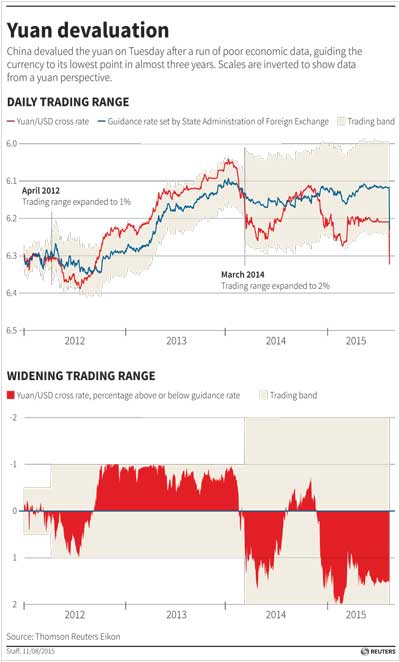Saturday Jan 10, 2026
Saturday Jan 10, 2026
Wednesday, 12 August 2015 00:00 - - {{hitsCtrl.values.hits}}
China devalued its currency on Tuesday after a run of poor economic data, a move it billed as a free-market reform but that some suspect could be the beginning of a longer slide in the exchange rate.
The central bank set its official guidance rate down nearly 2% prior to market open to 6.2298 yuan per dollar - its lowest point in almost three years - from 6.1162 the previous day in what it said was a change in methodology to make it more responsive to market forces.
“Since China’s trade in goods continues to post relatively large surpluses, the yuan’s real effective exchange rate is still relatively strong versus various global currencies, and is deviating from market expectations,” the central bank said.
“Therefore, it is necessary to further improve the yuan’s midpoint pricing to meet the needs of the market.” The central bank called it a “one-off depreciation”, but economists were divided over the significance of a move that appears to reverse the recent policy of maintaining a strong yuan, which has buttressed policy goals of boosting domestic consumption and outward investment.
Data released at the weekend showed China’s exports tumbled 8.3% in July, hit by weaker demand from Europe, the United States and Japan, and producer prices are well into their fourth year of deflation.
Collapsing prices for global commodities have been blamed for the producer price deflation, putting the country at risk of repeating the deflationary cycle that has blighted Japan for decades.
Growth in China, the world’s second-largest economy, has slowed markedly this year and is set to hit a 25-year low even if it meets its official 7% target.
Tuesday’s move sparked declines in the offshore yuan market and in currencies including the Australian dollar and the Korean won, and caused airline shares to fall, given the impact higher fuel prices will have on their bottom line. Share in exporters rose.
Some said the move was also to blame for a fall in futures contracts tracking the S&P 500 index, given the potential hit to U.S. exports to China.
The spot yuan was changing hands at at 6.3185 in mid-afternoon, 1.46% away from the midpoint.
Under the current regime, the spot yuan is allowed to rise or fall by 2% from the midpoint each day. In the past, the central bank set the midpoint by a formula based on a basket of currencies, but the methodology was never publicised and many believed the midpoint was frequently used as a way to bend the market to policy goals.
Under the new method, investors moving assets out of yuan could take the rate lower in the weeks ahead, raising the possibility of competitive currency depreciations worldwide.
The yuan had been locked in an extremely narrow intraday range since March, varying only 0.3%. On Tuesday, the spot yuan price touched its weakest point since September 2012 in early trade.
However, some economists said the move was not just a reaction to the export figures and was linked to Beijing’s push for the yuan to be included in a basket of reserve currencies known as Special Drawing Rights (SDR), which are used by the International Monetary Fund to lend money to sovereign borrowers.
The IMF proposed in a report this month to put off any move to add the yuan to its benchmark currency basket until after September 2016, and it gave mixed reviews of Beijing’s progress in making key financial reforms to its currency market.
Some of Asia’s most interventionist central banks are for now holding their nerve on currency policy after a major devaluation in the currency of one of their top trading partners, China.
China’s central bank said Tuesday’s surprise 1.9% devaluation of the yuan was a one-off move, while it also switched to a more market-determined benchmark for the currency’s daily trading band.
Even as market participants pushed the yuan down further to test a 2% daily limit, policymakers from South Korea, India, Indonesia and Japan said they saw no reason for tit-for-tat trade-war policies.
“We are not overly worried about the won (currency), but we are closely watching the market to see if there’s any excessive volatility happening,” a South Korean foreign exchange official told Reuters.
“This came as emerging-market currencies have already been depreciating against the dollar,” he said, while pointing to the yuan’s relative stability in the past few months even as emerging market currencies ceded ground to a rising U.S. dollar. China is Korea’s largest trading partner, accounting for a fifth of total trade last year. While the won has weakened relative to the yuan this year, Korean policymakers have been actively trying to encourage outflows from their country and talking down the won.
Some of the angst in Korea is over the how uncompetitive the won is against export competitor Japan, where the yen has been pushed down 50% against the dollar since 2012 as part of the government’s growth strategy.
Japanese policymakers shrugged off the yuan’s 2% devaluation.
“I don’t think the move would trigger a global currency war,” a Japanese policymaker said.
Senior Deputy Governor MirzaAdityaswara at Indonesia’s central bank pointed to how undervalued the rupiah currency already was, precluding the need for further depreciation.
Analysts estimate the yuan has risen by more than 18% in trade-weighted and inflation-adjusted terms against the currencies of its trading partners since the middle of last year, suggesting there is some margin before depreciation would raise concerns over trade competitiveness in the region.